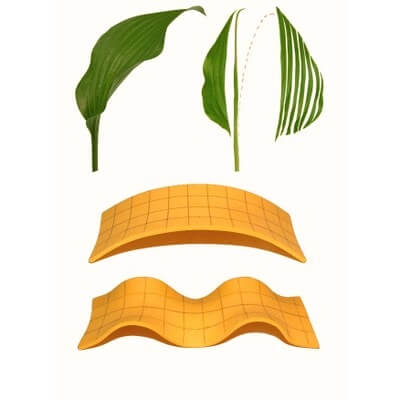News
Contact:
Michael Patrick Rutter
617-496-3815
CAMBRIDGE, Mass. – November 23, 2009 – Applied mathematicians dissected the morphology of the plantain lily (Hosta lancifolia), a characteristic long leaf with a saddle-like arc midsection and closely packed ripples along the edges. The simple cause of the lily's fan-like shape—elastic relaxation resulting from bending during differential growth—was revealed by using an equally simple technique, stretching foam ribbons.
Haiyi Liang, a postdoctoral student at Harvard's School of Engineering and Applied Sciences (SEAS), and L. Mahadevan, the Lola England de Valpine Professor of Applied Mathematics at SEAS and a core faculty member of the Wyss Institute for Biologically Inspired Engineering, were inspired to study the formation of laminae (thin leaf-like structures) because they are so commonplace in biology.
The work had its origins in conversations that Mahadevan had with experimental biologists Mimi Koehl at the University of California, Berkeley and Wendy Silk from the University of California, Davis, who showed him examples of such morphologies in long submarine algal blades.
"These blades have rippled edges when they grow in slowly moving water. When they are transplanted to environments that have rapidly moving water, they generate new blades which are much narrower," says Mahadevan. "This example of phenotypic plasticity, or the ability of the algae to change their shape in response to environmental forces, led to a paper co-authored with Koehl and Silk last year that focused primarily on the experimental findings."
Inspired by this, Mahadevan and Liang developed an analog model to understand how a long leaf is formed by pulling flat, foam ribbons, measuring approximately 4.3" x 1.5" (about the size of a large bookmark), beyond their elastic limit and then letting them go. These stretching strains were applied preferentially to the horizontal edges so that the foam ribbon naturally forms a saddle-like shape when it relaxes. In the same scenario, but with a four-fold increase of strain on the horizontal edges, ripples will form along the edges, producing a series of small undulating waves.
An equivalent growth-induced strain, highest along the edges and lessening toward the middle, occurs as a long leaf grows, leading to the elegant arc and serrated surface of the leaves in plants like the lily. This effect is widely seen, says Mahadevan, in a variety of common objects and activities.
"When knitting a scarf, as the number of stitches is increased as the knitter moves away from the center, the material forms a saddle shape. As the edge length becomes much larger ripples begin to appear. The same effect can be seen when thin potato slices are dropped into hot oil to make chips. You end up with a bulbous middle and wrinkled edges," he explains.
The researchers also dissected the leaves of the plantain lily to show that elastic strain resulting from differential growth led to the patterns seen in real leaves. From this simple experiment, the researchers then developed a mathematical model explaining the shape, using a combination of scaling concepts, stability analysis, and numerical simulations.
"While the phenomena has been studied previously, researchers did not consider the role of finite size of a leaf on the stability or the effect of boundaries. Further, our study characterizes, mathematically, the range of parameters that quantify the shape and diversity in leaf morphology," adds Mahadevan.
The resulting model has application in understanding a variety of artificial systems such as non-uniform thermal expansion, hydraulic swelling, and plasticity induced shape changes in thin laminae.
The research was supported by a Visiting Miller Professorship at the University of California, Berkeley, the Harvard University Materials Research Science and Engineering Center (funded by the National Science Foundation), and the Defense Advanced Research Projects Agency (DARPA).
Cutting-edge science delivered direct to your inbox.
Join the Harvard SEAS mailing list.
